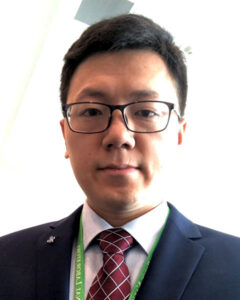 The International Phononics Society (IPS) has awarded Tianli Feng, assistant professor in the Department of Mechanical Engineering, the 2023 Brillouin Medal. The Medal is one of the top honors in the field of phononics, which is concerned with the quantum mechanics of vibrations, such as sound waves, and how they propagate through lattices of atoms.
The International Phononics Society (IPS) has awarded Tianli Feng, assistant professor in the Department of Mechanical Engineering, the 2023 Brillouin Medal. The Medal is one of the top honors in the field of phononics, which is concerned with the quantum mechanics of vibrations, such as sound waves, and how they propagate through lattices of atoms.
Feng and his colleague, Professor Xiulin Ruan from Purdue University, were recognized “for their formulation of four-phonon scattering theory and associated computational studies.”
The Brillouin medal, awarded every two years by the IPS, honors a specific contribution within in the field of phononics, including phononic crystals, acoustic/elastic metamaterials, nanoscale phonon transport, wave propagation in periodic structures, coupled phenomena involving phonons, topological phononics, and related areas.
Prof. Feng works on the interdisciplinary research areas of phonon physics and engineering. In the past, three-phonon scattering was the dominant phonon-phonon scattering mechanism. The higher-order four-phonon scattering was ignored due to the lack of general theory and perceived computational challenges. Ruan and Feng have been working on this problem since 2012, initially establishing a general theory of four-phonon scattering, and then extending the method to first principles. Their predictions explained the experimental temperature dependence of thermal conductivity in silicon. Later work also predicted that four-phonon scattering can significantly contribute to linewidth in infrared and Raman spectra for a wide range of materials.
“Four-phonon scattering is an intrinsic process in all crystals and determines the materials’ thermal transport ability and thermal radiative properties,” said Feng. “It is critical for discovering and designing materials for thermal barrier coatings, thermal management with ultra-high or ultra-low thermal conductivity, hypersonic vehicles, 2D functional devices, thermoelectrics, nuclear power plants, and radiative cooling.”